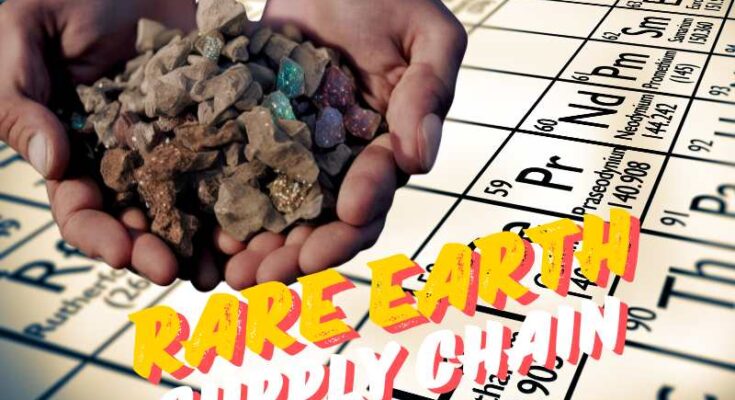U.S. Accelerates Efforts to Secure Rare Earth Supply Chain Beyond China
The U.S. is making strides to develop a rare earth supply chain
Reducing dependency on China’s market dominance by investing in domestic extraction and international trade deals.
The United States is making strategic moves to develop its rare earth supply chain as a means to reduce dependency on China, which currently dominates the global market due to significant investments and relaxed environmental regulations.
Notable efforts include exploring the extraction of rare earth elements from U.S. coal mines, notably the Uinta coal belt, as well as substantial financial commitments from the Department of Defense and Department of Energy to bolster domestic capabilities.
In light of soaring demand and rising prices, the U.S. is also pursuing international trade deals, though it faces stiff competition from China, especially in lithium-rich regions such as Latin America.
While still lagging behind China’s industrial prowess, these diversified initiatives signify a comprehensive push to safeguard economic and strategic interests amidst growing global demand for renewable energy resources.
Surge in Solar Installations Impacting California Grid
The U.S. Aims to Develop Rare Earth Supply Chain to Reduce Dependency on China
Introduction
Have you ever wondered why the United States is focusing so intensely on developing its own rare earth supply chain? The answer lies in the complex interplay of geopolitical, economic, and environmental concerns.
Currently, China dominates the global rare earth element (REE) market, providing a substantial share of the world’s supply, largely because of its extensive investment in this sector and more lenient environmental regulations.
The U.S. aims to reduce its dependency on China by strengthening its domestic supply chain, which entails everything from extraction to processing of these critical materials. This article will delve into why rare earth elements are so vital, how America plans to innovate and compete in this arena, and what the future may hold for global supply dynamics.
Understanding Rare Earth Elements
What Are Rare Earth Elements?
Rare earth elements (REEs) are a group of 17 chemical elements that are critical for high-tech industries, including renewable energy, electric vehicles, consumer electronics, and national defense. They are indispensable in manufacturing items such as smartphones, wind turbines, and missile guidance systems.
Why Are They Important?
Due to their unique magnetic, luminescent, and electrochemical properties, REEs are integral components in numerous advanced technologies. For example, neodymium is crucial for manufacturing powerful magnets used in electric vehicle motors and wind turbines. Similarly, yttrium is a key element in making phosphors for LED screens.
China’s Dominance in the Rare Earth Market
China’s Investment and Policies
China has become the global leader in the extraction and processing of REEs. This position was achieved through substantial investment in mining infrastructure and lenient environmental regulations, allowing for lower-cost production.
Natural Gas Surge in the U.S.: The Role of Technological Advancements
Implications for Global Supply
China’s dominance in the REE market enables it to control the pricing and availability of these crucial materials. Consequently, considerable economic and strategic risks are posed to countries dependent on China for their REE supply. The U.S. finds itself in such a position, underlining the urgency to develop alternative supply chains.
| Country | REE Production (Metric Tons) | Global Share (%) |
|---|---|---|
| China | 140,000 | 60 |
| United States | 38,000 | 16.5 |
| Myanmar | 30,000 | 13 |
| Australia | 17,000 | 7.2 |
| Other | 7,000 | 3.3 |
Table: Global REE Production and Share (Approximate Figures)
Exploring Domestic Sources
Extracting REEs from Coal Mines
One innovative approach U.S. researchers are exploring involves extracting rare earth elements from existing coal mines. According to research conducted by the University of Utah, elevated concentrations of REEs are found in the Uinta coal belt, suggesting that these elements could be extracted with minimal additional costs. This method promises a dual benefit: reducing waste in coal mines while providing a domestic source of rare earth elements.
Potential Economic and Environmental Benefits
Utilizing coal mines for REE extraction presents economic opportunities, reducing dependency on foreign sources. It also aligns with shifting environmental policies, as these processes could be more eco-friendly compared to traditional mining methods.
Rising Demand and Economic Implications
Increasing Global Demand
The demand for rare earth elements is skyrocketing, driven by the global push towards renewable energy and advanced technological developments. Wind turbines, electric vehicles, and a myriad of consumer electronic devices require REEs for optimal functionality.
Soaring Prices
As demand increases, so do prices. Higher REE prices benefit countries that can supply these materials but pose challenges for industries dependent on reasonably priced inputs. This economic dynamic underscores the strategic importance of developing a domestic supply chain.
U.S. Department of Defense and Department of Energy Initiatives
Defense Investments
Recognizing the critical importance of a secure supply of REEs, the U.S. Department of Defense has invested over $439 million since 2020 to establish domestic supply chains. These investments are aimed at reducing vulnerability and ensuring the availability of essential materials for national defense technologies.
Energy Sector Initiatives
The Department of Energy has allocated billions of dollars to kickstart the U.S. lithium industry, another critical component in the renewable energy landscape. Lithium is essential for battery technology, which powers everything from electric vehicles to grid storage solutions for renewable energy.
Summary of Investments
| Department | Focus Area | Investment Amount |
|---|---|---|
| Department of Defense | Military and Defense | $439 million |
| Department of Energy | Lithium Industry | Billions |
Table: U.S. Investments in Strategic Industries
International Trade Dynamics and Competition
Trade Deals and Alliances
The U.S. is actively seeking international trade deals to secure a diversified supply of REEs. These efforts often involve forming alliances with countries rich in rare earth resources and establishing mutually beneficial trade agreements.
Competition from China
Despite these efforts, the U.S. faces stiff competition from China, especially in lithium-rich regions like Latin America. China’s established presence and influence in these areas pose a significant challenge to diversifying the U.S. supply chain.
Case Study: University of Utah’s Findings
Uinta Coal Belt Research
A groundbreaking study by the University of Utah uncovered elevated concentrations of REEs in the Uinta coal belt. This research indicates that existing coal mines could be used to extract these elements efficiently, offering a promising solution to augment the domestic supply chain.
Cost-Effective Extraction
The ability to extract REEs from coal mines with minimal additional cost provides a significant advantage. This method not only contributes to economic viability but also reduces the environmental footprint associated with traditional mining practices.
Technological Innovations and Future Prospects
Closing the Gap with China
While the U.S. still lags behind China in the industrial development and market influence of REEs, it is exploring innovative methods to close this gap. Research and investment in advanced extraction technologies and recycling of REEs are vital components of this strategy.
New Extraction Techniques
Emerging technologies in REE extraction, including bioleaching and solvent extraction, offer promising avenues for increasing domestic production. These methods are more environmentally friendly and could significantly reduce the U.S. dependence on imported rare earth elements.
Recycling and Circular Economy
The concept of a circular economy, where used REEs are recycled and reintroduced into the supply chain, is gaining traction. This approach not only alleviates supply constraints but also supports sustainability goals by reducing waste and environmental impact.
Conclusion
Developing a robust domestic supply chain for rare earth elements is not just an economic imperative for the U.S.; it is a strategic necessity. With China currently holding significant sway over global REE markets, the risks of dependency are both clear and multifaceted. From innovations in extracting REEs from coal mines to substantial government investments, the U.S. is making concerted efforts to reduce its reliance on foreign sources.
The path forward involves overcoming significant challenges, including technological barriers and fierce international competition. However, through strategic investments, innovative research, and international collaborations, the U.S. has the potential to secure a more resilient and sustainable supply chain.
By taking proactive steps now, the United States can ensure it remains competitive in the rapidly evolving global landscape, meeting its needs for rare earth elements while also promoting economic and environmental sustainability.


